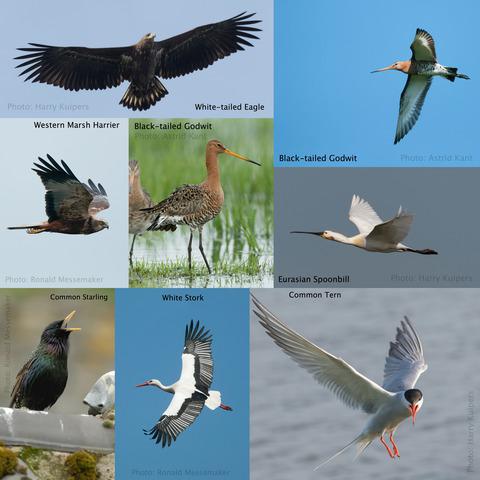当前位置:
X-MOL 学术
›
Ecol. Evol.
›
论文详情
Our official English website, www.x-mol.net, welcomes your
feedback! (Note: you will need to create a separate account there.)
Mortality limits used in wind energy impact assessment underestimate impacts of wind farms on bird populations.
Ecology and Evolution ( IF 2.3 ) Pub Date : 2020-06-04 , DOI: 10.1002/ece3.6360 Peter Schippers 1 , Ralph Buij 1 , Alex Schotman 1 , Jana Verboom 1, 2 , Henk van der Jeugd 3 , Eelke Jongejans 4
中文翻译:

风能影响评估中使用的死亡率限制低估了风电场对鸟类种群的影响。
更新日期:2020-07-25
Ecology and Evolution ( IF 2.3 ) Pub Date : 2020-06-04 , DOI: 10.1002/ece3.6360 Peter Schippers 1 , Ralph Buij 1 , Alex Schotman 1 , Jana Verboom 1, 2 , Henk van der Jeugd 3 , Eelke Jongejans 4
Affiliation

|
- The consequences of bird mortality caused by collisions with wind turbines are increasingly receiving attention. So‐called acceptable mortality limits of populations, that is, those that assume that 1%–5% of additional mortality and the potential biological removal (PBR), provide seemingly clear‐cut methods for establishing the reduction in population viability.
- We examine how the application of these commonly used mortality limits could affect populations of the Common Starling, Black‐tailed Godwit, Marsh Harrier, Eurasian Spoonbill, White Stork, Common Tern, and White‐tailed Eagle using stochastic density‐independent and density‐dependent Leslie matrix models.
- Results show that population viability can be very sensitive to proportionally small increases in mortality. Rather than having a negligible effect, we found that a 1% additional mortality in postfledging cohorts of our studied populations resulted in a 2%–24% decrease in the population level after 10 years. Allowing a 5% mortality increase to existing mortality resulted in a 9%–77% reduction in the populations after 10 years.
- When the PBR method is used in the density‐dependent simulations, the proportional change in the resulting growth rate and carrying capacity was species‐independent and largely determined by the recovery factor (F r). When F r = 1, a value typically used for robust populations, additional mortality resulted in a 50%–55% reduction in the equilibrium density and the resulting growth rate. When F r = 0.1, used for threatened populations, the reduction in the equilibrium density and growth rate was about 5%.
- Synthesis and applications . Our results show that by allowing a mortality increase from wind farm collisions according to both criteria, the population impacts of these collisions can still be severe. We propose a simple new method as an alternative that was able to estimate mortality impacts of age‐structured stochastic density‐dependent matrix models.
中文翻译:

风能影响评估中使用的死亡率限制低估了风电场对鸟类种群的影响。
风力涡轮机碰撞导致鸟类死亡的后果越来越受到人们的关注。所谓的可接受的种群死亡率限值,即假设 1%–5% 的额外死亡率和潜在的生物清除 (PBR),为确定种群生存能力的降低提供了看似明确的方法。
我们使用随机密度无关和密度依赖研究了这些常用死亡率限制的应用如何影响普通椋鸟、黑尾塍鹬、沼泽鹞、欧亚琵鹭、白鹳、普通燕鸥和白尾雕的种群莱斯利矩阵模型。
结果表明,种群生存能力对死亡率的小幅增加非常敏感。我们发现,在我们研究的种群中,羽化后群体的死亡率每增加 1%,就会导致 10 年后种群数量下降 2%–24%,而不是产生可以忽略不计的影响。允许现有死亡率增加 5%,导致 10 年后人口减少 9%–77%。
当 PBR 方法用于密度相关模拟时,所得生长速率和承载能力的比例变化与物种无关,并且很大程度上由恢复因子 ( F r ) 决定。当F r = 1(通常用于稳健种群的值)时,额外的死亡率导致平衡密度和由此产生的增长率下降 50%–55%。当F r = 0.1时,用于受威胁种群,平衡密度和生长率降低约5%。
合成与应用。我们的结果表明,如果根据这两个标准允许风电场碰撞造成的死亡率增加,这些碰撞对人口的影响仍然可能很严重。我们提出了一种简单的新方法作为替代方法,能够估计年龄结构随机密度依赖矩阵模型的死亡率影响。











































 京公网安备 11010802027423号
京公网安备 11010802027423号